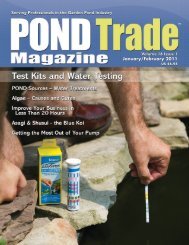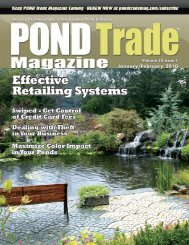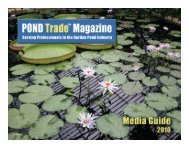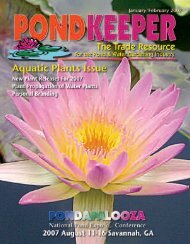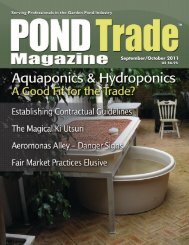Download the May / June, 2010 PDF - Pond Trade Magazine
Download the May / June, 2010 PDF - Pond Trade Magazine
Download the May / June, 2010 PDF - Pond Trade Magazine
- No tags were found...
You also want an ePaper? Increase the reach of your titles
YUMPU automatically turns print PDFs into web optimized ePapers that Google loves.
<strong>the</strong> scales appear only along <strong>the</strong>dorsal line, or backbone, andpossibly along <strong>the</strong> lateral lines.Look for <strong>the</strong> dark centeredscales and clean Platinum skinto identify <strong>the</strong> Doitsu Kujaku.Due to <strong>the</strong> diverse lineageof Kujaku culling its offspring isquite a challenge. Not only do<strong>the</strong> young Kujaku resemble‘pond mutts’ at an early age,many of <strong>the</strong>ir siblings are ofvarious varieties. We can alsofind Ogon, Kikusui, Kohaku,Aka Matsuba, Gin Matsuba,Asagi, Hariwake just to name afew from a single pairing ofKujaku breeder koi. Then addin <strong>the</strong> variable of Doitsu scalesand <strong>the</strong> task of culling100,000+ babies is not for <strong>the</strong>faint of heart.Some possible varieties found within a Kujaku spawn.Making Beautiful Babies...At Kloubec Koi Farm we generally designate two or threemud-ponds to hold <strong>the</strong> enormous number of Kujaku fry thatwe hatch most every year. (Photo 1 of three-day-old Kujakufry) Nursery mud-ponds are prepared to receive <strong>the</strong> young fry.Each pond is drained and cleaned of any remaining fish. TheThey’re Alive! …(Now get to work!)A first culling is done around <strong>the</strong> 45-day mark. It is duringthis stage when we begin to see which little fish will exhibit agood metallic sheen. Any fish with defects are discarded during<strong>the</strong> first cull. Notice <strong>the</strong> different varieties. Not only are wereviewing every Kujaku, we have to evaluate <strong>the</strong> o<strong>the</strong>rs todetermine if <strong>the</strong>y are worthy of stocking back into a mud-pond.Some of <strong>the</strong> koi are obvious at this age, but many are not. Atthis time any inferior fish will not make <strong>the</strong> cut. Back to <strong>the</strong>mud-pond <strong>the</strong>y go. After restocking <strong>the</strong> koi are fed three to fivetimes per day.At <strong>the</strong> second cull you can definitely see <strong>the</strong> vast assortmentof varieties. This sample of culled fish is ready to go back intoa mud pond. Before long it will be time to cull <strong>the</strong>m again.1. Kujaku frypond bottoms will be dredged if necessary. Filtered water willre-fill each pond, and fertilizer added to produce <strong>the</strong> perfectbloom. The fry are stocked out into <strong>the</strong> ponds at dusk. Thenwe take a sigh of relief before we start to anguish over <strong>the</strong>iruncertain survival.<strong>May</strong>/<strong>June</strong> <strong>2010</strong>POND <strong>Trade</strong> <strong>Magazine</strong>19



